Uranus, the seventh planet from the Sun, is the third largest and fourth most massive planet in our Solar System. It is 14.5 times more massive than Earth, making it the lightest among the giant planets in our Solar System.

Similar to the other gas giants present in our solar system, Uranus possesses its own ring system, although it is not as magnificent as Saturn’s.
Unlike Saturn and Jupiter, which consist primarily of hydrogen and helium, Uranus lacks metallic hydrogen but contains a substantial amount of ice. As a result, Uranus has such a low density that it would not sink if submerged in water, given the presence of a basin large enough to accommodate this colossal planet.
The composition of Uranus’s interior
Uranus’s internal makeup consists of different layers. The outermost layer, which occupies about 20% of the planet’s radius, is a hydrogen-helium atmosphere. Beneath this atmosphere lies the majority of the planet, comprising approximately 60% of its total radius. This region is composed of a mantle made up of various ices, including water, ammonia, and methane ice. Finally, at the core of Uranus is a rocky core that is relatively small in size. This core has a mass equivalent to approximately 0.55 to 3.7 times that of Earth and has a radius that constitutes about 20% of the planet’s total radius.
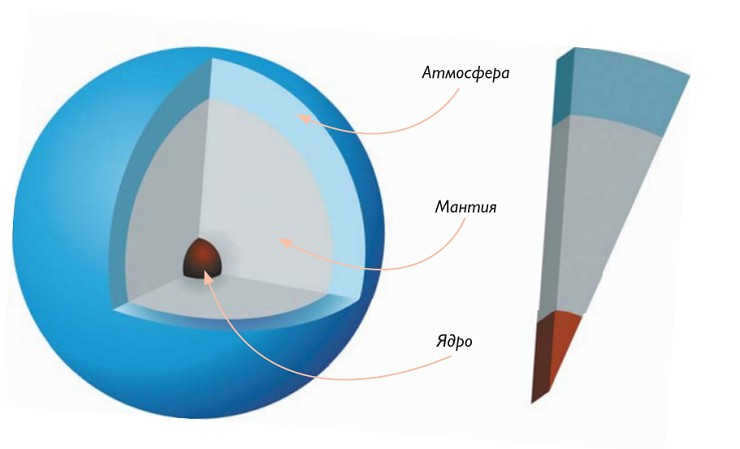
Uranus possesses limited cloud bands, cyclones, and atmospheric disturbances. The winds have been persistently blowing for centuries, with velocities that can reach up to 900 kilometers per hour – gusts that could easily sweep away any form of life on the planet.
Who is Uranus?
Uranus is known as the sky god in ancient Greek mythology. The name Uranus comes from the Greek word “uranos,” which means “sky.” This planet is named after the deity Uranus, who is the father of Kronos (also known as Saturn), Aphrodite (also known as Venus), Japetus, Dione, Rhea, Thephia, and Theba. Uranus is also the grandfather of Zeus (also known as Jupiter) and Poseidon (also known as Neptune). In essence, Uranus can be considered a cosmic patriarch.

Exploration of the initial planet of the contemporary era
Uranus was initially detected as the first planet in the contemporary era. While most planets in the solar system were already recognized in ancient times, with some being observed by the ancient Greeks over 3000- 2500 years ago, Uranus became the first planet to be discovered following the invention of the telescope in 1690. The English astronomer John Flemsteed was the first to observe Uranus through a telescope, although he mistakenly identified it as a distant star. It was not until nearly a century later, in 1781, that the English astronomer William Herschel conclusively demonstrated that Uranus was indeed a planet within our solar system.

Uranus’ Moons
As of 2018, there are a total of 27 known natural satellites that orbit around the planet Uranus. These moons can be categorized into three different groups. The medium orbits of Uranus are occupied by the five largest moons: Miranda, Ariel, Umbriel, Titania, and Oberon. These moons have a regular spherical shape. Closer to Uranus, there are thirteen inner satellites that are sometimes even found within its rings. These inner satellites are relatively small and have a shapeless, blocky appearance, consisting mostly of ice.
The irregular shapes of the nine satellites orbiting beyond Oberon’s orbit are unique. Most of the moons of Uranus are named after characters from the plays written by the English poet William Shakespeare. Specifically, Titania, the largest moon of Uranus, is named after the queen of fairies and elves from the play A Midsummer Night’s Dream. Titania ranks as the eighth largest satellite in the solar system and is composed of approximately equal amounts of rock and ice.
What sets Uranus apart is the small size of all its satellites. If combined, their total mass would be less than one third that of Ganymede, the largest moon in the solar system and a satellite of Jupiter. To provide visual clarity, the above image displays the largest moons of Jupiter (above) and Uranus (below).
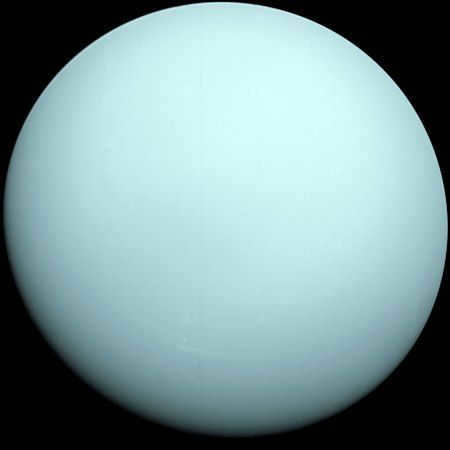

Uranus is the seventh celestial body in our solar system when it comes to its distance from the Sun. It possesses the third most significant planetary radius and the fourth most significant planetary mass among all the planets in the Solar System. It was the first planet that was observed using a telescope [1].
Uranus and Neptune exhibit a comparable structure and chemical makeup to the large gas giants Saturn and Jupiter. Due to this similarity, scientists often classify them as a separate category known as “ice giants.” The composition of Uranus’ atmosphere resembles that of Jupiter and Saturn, primarily consisting of hydrogen and helium, but with higher concentrations of water, ammonia, methane, and trace amounts of other hydrocarbons. Remarkably, it possesses the coldest atmosphere in the entire solar system, with temperatures dropping as low as 49 K (-224 °C). The planet boasts a intricate cloud system, with water dominating the lower clouds and methane prevailing in the highest cloud layer. Internally, Uranus is primarily composed of ice and rock[1].
Just like other massive planets, Uranus has a system of rings, a magnetosphere, and 27 moons. What sets this system apart is its unique configuration, as the planet’s axis of rotation is tilted sideways, nearly aligning with its solar orbit. As a result, Uranus’ north and south poles are situated where most other planets have their equator. The wind speeds on Uranus can reach an astounding 250 m/s (900 km/h).
The name of the planet is derived from a character in Greek mythology, which is a Latinized version of the Greek sky deity Uranus (Ουρανός).
Physical attributes
There are numerous arguments suggesting that the disparities between ice giants and gas giants originated early in the formation of our solar system. The prevailing belief is that our solar system emerged from a colossal rotating cloud composed of gas and dust called the Protosolar Nebula, or simply the Solar Nebula. Over time, this cloud gradually thickened and coalesced into a central solar disk. The majority of the hydrogen and helium within the cloud participated in the formation of our Sun. Simultaneously, dust particles clumped together and began forming protoplanets. As these protoplanets grew, some developed a strong enough gravitational pull to attract and accumulate the remaining gas in their vicinity. They continued to amass gas until reaching an exponential threshold. In contrast, the ice giants managed to accumulate significantly less gas than their gas giant counterparts – only a few times the mass of Earth. Consequently, their mass did not surpass this threshold. Despite current theories regarding the formation of our solar system, the origin of Uranus and Neptune poses certain challenges. These planets are disproportionately large given their distance from the Sun. It is plausible that they were once situated closer to the Sun and subsequently experienced orbital shifts. However, recent advancements in planetary modeling techniques suggest that Uranus and Neptune could have indeed formed in their current locations, thereby negating the significance of their actual sizes in relation to the theory of solar system origins [2].
Unlike Jupiter and Saturn, which are primarily composed of hydrogen and helium, Uranus is believed to have a smaller proportion of these elements. Instead, the majority of its non-ice mass is made up of rocky material. Unlike Jupiter and Saturn, Uranus does not have a localized rocky core and its structure is more uniform.
The unique color of Uranus is caused by the presence of methane in its atmosphere, which absorbs red light. According to the standard model, Uranus is composed of three main layers: a central rocky core made of silicate and iron-nickel, a middle layer of icy mantle, and an outer shell of hydrogen and helium gas. The core is relatively small, with a mass equivalent to only 0.55 times that of Earth and a radius less than 20% of Uranus’ total radius. The mantle, on the other hand, accounts for most of Uranus’ mass, weighing approximately 13.4 times that of Earth. The upper atmosphere, which is relatively insignificant in terms of mass, extends over 20% of Uranus’ radius and weighs about 0.5 times that of Earth. Interestingly, the icy mantle is not composed of traditional ice, but rather a hot and thick liquid consisting of water, ammonia, and other volatile substances. This highly conductive liquid is often referred to as a hydroammoniacal ocean. Due to its liquid internal structure, Uranus lacks a solid surface. The gaseous atmosphere gradually transitions into the liquid layers within the planet.
One of the distinguishing traits of Uranus is its nearly 100-degree tilt of its rotation axis. Consequently, during certain phases of its orbit, one of its poles is directly exposed to the Sun, while the other remains in perpetual darkness. During other periods, the Sun rises and sets as usual, and the duration of a day on Uranus spans 42 years [6].
When Voyager 2 explored Uranus in 1986, the planet’s south pole was facing almost directly towards the Sun. There is ongoing scientific debate about how to determine which of Uranus’ poles is north and which is south. One perspective is that Uranus has a slightly less than 90-degree axis tilt and rotates in a retrograde (counterclockwise) direction. Another perspective is that Uranus has a slightly greater than 90-degree axis tilt and rotates clockwise. Both definitions are equally valid, but they result in different definitions for the north and south poles of Uranus. This unique orientation causes the planet’s poles to receive more solar energy compared to planets with more moderate axis tilts. However, despite this, the temperature at Uranus’ equator is higher than at the poles due to an unknown mechanism of heat redistribution, either from the planet’s interior or from the Sun. Scientists believe that the large tilt of Uranus’ rotation axis was caused by a collision with a large protoplanet shortly after the planet formed. This axis tilt also leads to pronounced seasonal changes on Uranus. During the Voyager 2 mission, when the Sun was shining on the planet’s pole, the cloud belts in Uranus’ atmosphere were very thin and faint. However, recent observations from the Hubble Space Telescope have revealed more extensive and distinct cloud belts, likely due to the Sun shining almost directly on the equator[7].
The composition of Uranus’ atmosphere is mainly hydrogen and helium, with an abundance of volatile substances (referred to as “ice”) such as water, ammonia, and methane found at deeper levels. However, the upper atmosphere is characterized by a lack of heavier gases due to its low temperature. Uranus has the coldest atmosphere among all the planets in our solar system, reaching temperatures as low as 49 K. The atmosphere can be divided into three primary layers: the troposphere, spanning altitudes of -300 to 50 km and pressures of 100 to 0.1 bar; the stratosphere, extending from 50 to 4000 km with pressures of 0.1 to 10-10 bar; and the hot thermosphere (and exosphere), starting at altitudes of 4000 km and extending several uranium radii from the nominal surface with a pressure of 1 bar. Unlike Earth’s atmosphere, Uranus does not have a mesosphere. The troposphere is composed of four types of clouds: methane clouds at approximately 1.2 bar, hydrogen sulfide and ammonia clouds at 3-10 bar, ammonium hydrosulfide clouds at 20-40 bar, and clouds below 50 bar. Only the top two cloud layers have been directly observed, with deeper clouds remaining unseen. Individual bright tropospheric clouds are rare on Uranus, likely due to slow convection within the planet’s interior. However, these clouds have been utilized to measure the planet’s zonal winds, which can reach speeds of up to 240 m/s. Our knowledge of Uranus’ atmosphere is limited, as data has only been obtained from one spacecraft, Voyager 2, which flew by the planet in 1986 [8].
Prior to the Voyager 2 mission, there were no specialized measurements conducted on the magnetic field of Uranus, leaving its nature a mystery. However, the data collected by Voyager 2 revealed that Uranus has a peculiar magnetic field. Unlike other planets, the magnetic field of Uranus is not aligned with the planet’s geometric center and is instead tilted at an angle of 59° to the axis of rotation. Additionally, the magnetic dipole is situated one-third of the planetary radius away from the center of Uranus, specifically towards the south pole of rotation. This unique configuration gives rise to an extremely asymmetric magnetosphere, where the strength of the magnetic field at the surface can vary significantly between the northern and southern hemispheres. In the southern hemisphere, the surface magnetic field strength can be as low as 10 μT, whereas in the northern hemisphere, it can reach values as high as 110 μT. On average, the surface field strength is measured to be 23 μT. In contrast, the Earth’s magnetic field is relatively symmetrical, with similar strength at both poles, and its magnetic equator is approximately parallel to its geographic equator [9].
The dipole moment of Uranus is 50 times greater than that of Earth. Neptune also has a magnetic field that is similarly shifted and tilted, suggesting that this may be a common characteristic of ice giants. One theory proposes that the magnetic fields of ice giants, unlike those of Earth and gas giants, are generated by motion at relatively shallow depths, such as in a water-ammonia ocean. Another possible explanation for the structure of the magnetosphere is the presence of liquid diamond oceans inside Uranus, which deflect the magnetic field. Despite its unusual location, Uranus’ magnetosphere is similar to those of other planets in many ways, with a main shock located about 23 times the radius of Uranus ahead of itself, a magnetopause at 18 times the radius, a fully developed magnetic tail, and radiation belts. In general, the structure of Uranus’ magnetosphere differs from that of Jupiter but is more similar to that of Saturn. Uranus’ magnetic tail is twisted into a spiral resembling a corkscrew. The magnetosphere of Uranus contains charged particles, primarily protons and electrons, with a small amount of H2+ ions. Heavier ions have not yet been detected. Many of these particles likely originate from the thermosphere. The energies of ions and electrons can reach up to 4 and 1.2 megaelectronvolts, respectively. When Uranus’ satellites pass through the magnetosphere, they leave noticeable gaps. The particle flux is high enough to cause darkening or cosmic weathering of their surfaces over a relatively short period of 100,000 years. This may explain the uniform dark coloration of Uranus’ satellites and rings [9].
As of March 2023, a total of 27 natural satellites have been discovered within the Uranus system. These satellites are named after characters found in the works of William Shakespeare and Alexander Pope. Among these satellites, there are five main and largest ones, namely Miranda, Ariel, Umbriel, Titania, and Oberon. The Uranus satellite system is considered to be the least massive among the satellite systems of the gas giants. In fact, the combined mass of these five satellites is less than half of the mass of Neptune’s satellite Triton. The largest satellite in the Uranus system, Titania, has a radius of only 788.9 km, which is less than half the radius of the Moon but larger than the radius of Saturn’s second largest satellite, Rhea [10].
The satellites orbiting Uranus consist of a combination of ice and rock, with a roughly equal ratio of 50:50. Additionally, the ice present in these satellites may contain ammonia and carbon dioxide. Among these moons, Ariel stands out with its relatively young surface and minimal number of craters. On the other hand, Umbriel’s surface is believed to be the oldest, judging by the size and abundance of craters. Miranda, on the other hand, showcases a unique landscape featuring deep canyons, terraces, and chaotic formations that can reach depths of up to 20 kilometers. One possible explanation for this is that Miranda experienced a collision with another celestial body, causing it to break apart and subsequently reform due to the influence of gravity [11].
Study’s Historical Background
Uranus, the initial planet recognized through contemporary scientific methods, has a long history of being observed prior to its official classification as a planet. Throughout human history, Uranus was often mistaken for a star by astronomers. One of the earliest documented observations of Uranus was made by Hipparchus in 128 BC, who initially identified it as a star [12].
Between 1750 and 1769, French astronomer Pierre Charles Lemonnier made at least twelve observations of Uranus, including four consecutive nights. On March 13, 1781, William Herschel discovered the planet from his home in Bath, initially mistaking it for a comet. Despite Herschel’s insistence on calling it a comet, other astronomers began to suspect that it was something else. Russian astronomer Andrei Ivanovich Leksel was the first to calculate the orbit of the new object, and its nearly circular orbit led him to conclude that it was a planet, not a comet. Johann Ehlert Bode described Herschel’s discovery as a previously unknown planet orbiting beyond Saturn’s orbit. It was soon recognized as a planet[13].
“Voyager 2 was the sole spacecraft that approached the planet. After more than eight years since its launch in 1977, Voyager reached its closest point to Uranus on January 24, 1986, while en route to Neptune. It was situated approximately 81,500 km from the gas giant’s atmospheric layers. During its mission, the spacecraft extensively examined the composition of Uranus’ atmosphere, identified 10 previously unknown satellites, and investigated the planet’s distinctive weather patterns influenced by its axis tilt of 97.77°. Moreover, Voyager 2 conducted comprehensive studies of Uranus’ five largest satellites and observed the nine known rings, ultimately discovering two additional rings [14].”
- ↑ 1,01,11,2URAN – The Big Russian Encyclopedia – electronic version(unpublished) . old.bigenc.ru. Date of reference: March 29, 2023.
- ↑Anatoly Trutnev.Anomalous arrangement of the planets of the solar system. – Litres, 2022-05-15. – 89 p. – ISBN 978-5-04-434066-4.
- ↑Mass of Uranus: significance and comparison with other planets(unpublished). . v-kosmose.com.. Date of access: March 29, 2023.
- ↑What’s Concealed in Uranus: from nucleus to surface Planet Uranus: orbit, structure, composition(unpublished) . oplanetah.ru. Date of address: March 29, 2023.
- ↑Planet Uranus: description, photos, and interesting facts(currently unavailable). . v-kosmose.com. Last accessed: March 29, 2023.
- ↑Alexander Volkov.Earth and Sky. – FTM, 2013-11-11. – 178 p. – ISBN 978-5-4467-0124-7.
- ↑U R A N U S: Turquoise Planet (Russian)(not yet published)?. Date of circulation: March 29, 2023.
- ↑U R A N U S: Description of Uranus’ atmosphere with photos(not yet published) . v-kosmose.com. Last accessed: March 29, 2023.
- ↑ 9,09,1Magnetosphere of Uranus(Russian). . StudFiles. Date of circulation: March 29, 2023.
- ↑ Uranus has satellites that contain active oceans Universe Today.(Russian)(unpublished)? (March 22, 2023). Date of circulation: March 29, 2023.
- ↑Satellite Miranda: detailed description and high-resolution photo(not available). . v-kosmose.com. Date of access: March 29, 2023.
- ↑Bjorn Carey published.Long Lost Star Catalog Found in Plain Sight(English). Space.com (January 24, 2005). Date of access: March 29, 2023.
- ↑Biography of Andrei Leksel(unpublished). . v-kosmose.com.. Date of access: March 29, 2023.
- ↑Uranus Exploration: missions with photos and important dates(unpublished). . v-space.com.. Date of access: March 29, 2023.
This article is considered “completed”. This designation does not indicate the article’s quality, but rather signifies that it has sufficiently covered the main topic. If you wish to enhance the article, feel free to make edits!
Although scientists have identified all the planets in the Solar System, this doesn’t mean that they have complete knowledge about them. Furthermore, thanks to the data gathered from various satellites and probes, experts continue to make new discoveries almost on a daily basis. Here, we will share what scientists currently know about Uranus and how this planet has gained its reputation as the most peculiar one.
Explore the topic of “Hitech” on
What information do we have about Uranus?
Uranus, the seventh planet from the Sun, was the first to be discovered by scientists. Despite being visible to the naked eye, it was initially mistaken for a star due to its faintness and slow orbit. One of Uranus’ distinctive features is its sharp tilt, which causes its axis to almost directly face the Sun. On March 13, 1781, British astronomer William Herschel spotted Uranus through his telescope while observing stars that were about 10 times dimmer than what could be seen with the naked eye. Initially, he mistook it for another star, but a year later he realized it was actually a planet. The name “Uranus” was commonly adopted in 1850 and is derived from the Greek celestial deity Uranus, who was one of the earliest lords of the heavens. It is the only planet in our solar system to be named after a Greek god instead of a Roman god. Before settling on the name Uranus, several other names were proposed for the newly discovered planet, including Hypercronius (meaning “above Saturn”), Minerva (the Roman goddess of wisdom), and Herschel in honor of its discoverer. To please King George III of England, Herschel suggested the name Georgium Sidus (meaning “Georgian Planet”), but this idea was not well-received outside of England and King George’s native Hanover, Germany. The German astronomer Johann Bode, who provided a detailed description of Uranus’ orbit, ultimately gave the planet its final name. Bode argued that since Saturn was the father of Jupiter, the new planet should be named after Saturn’s father.
Contrary to the rest of the planets in our solar system, Uranus has a unique characteristic – it is tilted to such an extent that it orbits the Sun on its side, with its axis of rotation nearly pointing directly at the star. The reason for this peculiar orientation is believed to be a collision with either a planet-sized object or multiple smaller objects shortly after Uranus was formed. A recent study conducted in 2018 suggests that the celestial body that collided with Uranus could have been twice the size of our own planet Earth.
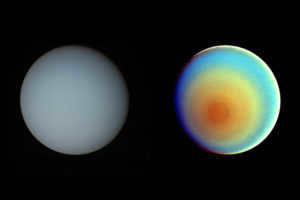
The unique tilt of Uranus results in the occurrence of extreme seasons that last for approximately 20 years. As a consequence, for nearly a quarter of an Uranian year, which is equivalent to 84 Earth years, the sun shines directly over each pole, while the other half of the planet experiences a prolonged period of darkness and cold winter.
The exceptional tilt of Uranus’ axis might be responsible for the occurrence of unusual weather phenomena. NASA suggests that when sunlight reaches certain regions after years of absence, it warms up the atmosphere and triggers the formation of massive spring storms.
However, back in 1986, Voyager 2 captured images of Uranus during the peak of summer in its southern hemisphere. At that time, the spacecraft observed a bland and featureless sphere with only around 10 discernible clouds. This unremarkable appearance led to Uranus being labeled as “the most uninteresting planet.” These findings were reported by astronomer Heidi Hummel in her chapter, “The Ice Giant Systems of Uranus and Neptune,” which is part of the book Solar System Update (Springer, 2007). Fortunately, as technology advanced over the years, telescopes like Hubble allowed scientists to witness the changing seasons on Uranus, leading to the discovery of extreme weather phenomena.
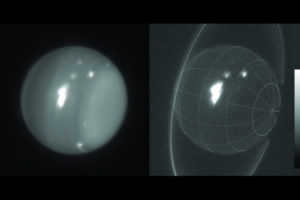
During the year 2014, astronomers were witness to the emergence of summer storms on the planet Uranus. Strangely enough, these immense storms occurred seven years after the planet’s closest approach to the Sun, and it remains an enigma as to why these colossal storms occurred following the planet’s maximum solar heating.
Additional peculiar weather phenomena on Uranus includes the occurrence of diamond rain, which is believed to descend thousands of miles beneath the icy surface of enormous planets like Uranus and Neptune. It is hypothesized that carbon and hydrogen are subjected to intense temperatures and pressure in the deep atmospheres of these planets, causing the formation of diamonds. These diamonds are then believed to sink downwards, eventually settling around the cores of these celestial bodies.
The discovery of Uranus’ rings followed the observation of Saturn’s rings, leading astronomers to understand that rings are not unique to Saturn but are a common characteristic of planets.
Uranus possesses two distinct ring systems. The inner system primarily consists of narrow, dark rings, while the outer system, which was identified by the Hubble Space Telescope, features two more distant rings that exhibit vibrant colors: one red and one blue. To date, scientists have identified a total of 13 rings encircling Uranus.
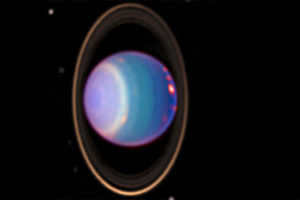
A 2016 research revealed that the bands encircling Uranus, Saturn, and Neptune might be the remaining fragments of dwarf planets similar to Pluto, which once ventured too close to the massive celestial bodies. These dwarf planets were disintegrated by the overwhelming gravitational force and are now preserved as rings.
Uranus possesses a total of 27 known satellites. Instead of being named after characters from Greek or Roman mythology, its initial four moons were given names derived from magical beings in English literature, such as those found in William Shakespeare’s A Midsummer Night’s Dream and Alexander Pope’s The Abduction of the Curl. Astronomers have since perpetuated this tradition by selecting moon names from the works of Shakespeare or Pope.
Oberon and Titania are the largest moons of Uranus, and they were the first ones to be discovered by Herschel in 1787. William Lassell, who also spotted a moon orbiting Neptune for the first time, found the next two moons of Uranus, Ariel and Umbriel. It took almost a century before Gerard Kuiper, the Dutch-American astronomer famous for his work on the Kuiper Belt, discovered Miranda in 1948.
In 1986, Voyager 2 explored the Uranus system and uncovered 10 more moons, all with diameters ranging from 26 to 154 kilometers: Juliet, Puck, Cordelia, Ophelia, Bianca, Desdemona, Portia, Rosalind, Cressida, and Belinda. Each of these moons is composed of approximately equal parts water ice and rock.
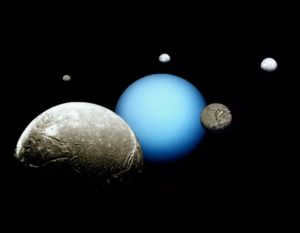
Ever since then, astronomers have been using Hubble and ground-based observatories to discover more about Uranus and its satellites. So far, they have found a total of 27 satellites, but it has not been an easy task. These satellites are quite small, measuring only 12 to 16 kilometers across. They are also incredibly dark, even darker than asphalt. Additionally, they are located nearly 4.8 billion kilometers away from Earth.
Among these satellites are Cordelia, Ophelia, and Miranda. These three are surrounded by a cluster of eight smaller satellites. It is still a mystery how these small satellites managed to avoid colliding with each other. Furthermore, anomalies in Uranus’s rings have led scientists to suspect that there may be even more undiscovered moons orbiting the planet.
Aside from satellites, Uranus might have a group of Trojan asteroids – objects in the same orbit as the planet – in a specific area called the Lagrange point. The initial discovery of one of these asteroids was made in 2013, despite previous beliefs that the planet’s Lagrange point would be too unstable to accommodate such objects.
As many students are aware, Uranus is the furthest planet from the sun in our solar system. Beyond Uranus lies Neptune, and potentially even further away, there could be another large planet (referred to as the “Ninth Planet” by astronomers who proposed its existence). Planetologists were surprised to learn that Neptune is not the coldest planet in our solar system; that title belongs to Uranus. This is because Uranus lacks an internal heat source to supplement the heat from the sun.
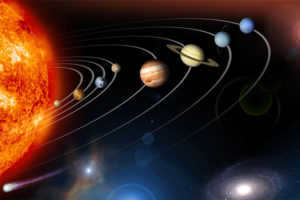
A recent investigation into Uranus
The origin of Uranus and Neptune remains an enigma, even within the context of the solar system. A team of researchers from the Universities of Zurich and Cambridge, affiliated with the Swiss NCCR PlanetS, have put forward an intriguing hypothesis supported by extensive simulation. The results of their study have been published in the esteemed scientific journal Nature Astronomy.
Despite our knowledge of all the planets in the solar system, there is still much to be unveiled. Thanks to the data collected by various satellites and probes, scientists continue to make groundbreaking discoveries on a regular basis.
According to a report by Planet Today, Uranus has once again proven itself to be a unique planet. Its rotation on its own axis is in a retrograde direction, unlike other planets that rotate like a wolf. Instead, Uranus rotates more like a rolling ball. This rotation not only affects the planet’s day and night cycles, but also its magnetic poles.
A recent study by astronomers in Georgia has revealed that Uranus’ magnetic field rotates along with the planet. In other words, the planet’s magnetic poles shift on a daily basis. If the Earth were to experience a pole shift, it would be at risk of complete collapse. However, on Uranus, this catastrophe occurs every day.
To further investigate these unique characteristics of Uranus and other aspects of the solar system’s most unusual planet, NASA scientists are planning to launch an unmanned mission to Uranus.
Click here for more information
Lagrange points, also known as libration points or L-points, refer to specific points in a two-body system where a third body, with a very small mass and only affected by gravitational forces from the first two bodies, can remain stationary relative to those bodies.
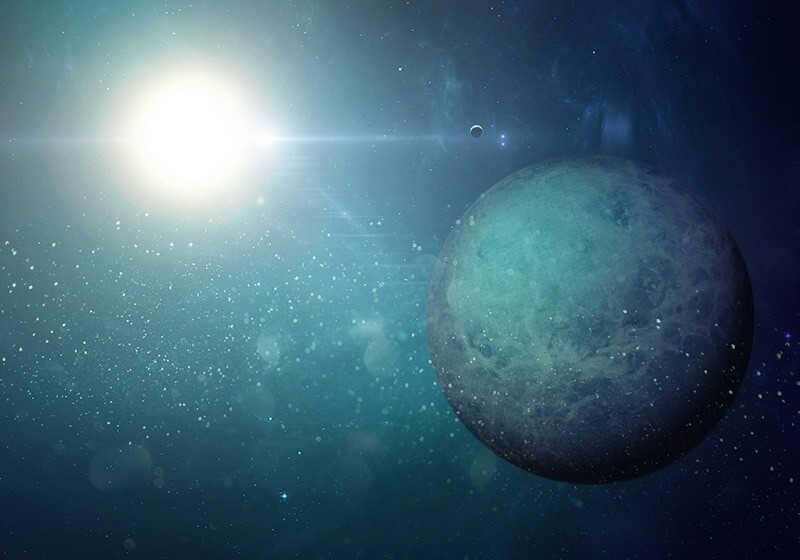
The planet Uranus, also known as Uranus since about 1850, got its name from the ancient Greek god Uranus, who was considered one of the earliest rulers of the celestial realm. Unlike other planets, Uranus is unique in being named after a Greek god rather than a Roman god.
Prior to settling on the name Uranus, there were several other suggestions for the newly discovered planet. Some of these included Hypercronius, meaning “higher than Saturn,” and Minerva, the Roman goddess of wisdom. There was even a suggestion to name it George Sidus, meaning “Planet George,” in order to honor King George III of England. However, this idea did not gain popularity outside of England.
This is only one of the many fascinating pieces of information about Uranus, here we have gathered a collection of 10 additional facts for children – an overview of a celestial object that stands out from the rest.
Known as an ice giant

The term “ice giant” emerged in the 1990s as scientists recognized the distinct composition of Uranus and Neptune compared to Jupiter and Saturn. Categorizing them separately better represents the differences in the formation of the outer planets, providing astronomers with a clearer understanding of the formation of our solar system and others.
Uranus and Neptune consist primarily of hydrogen and helium, but they also possess heavier elements like oxygen, carbon, nitrogen, and sulfur. Below their relatively thin layers of hydrogen and helium, the mantles of these planets are predominantly composed of compressed, slushy water and ammonia.
In contrast to other gas giants, Uranus and Neptune have proportionally larger rocky ice cores. It is this characteristic that earns them the designation of ice giants.
Gives off less heat than it receives from the Sun
The reason Uranus emits a lower amount of heat compared to the heat it receives from the Sun is due to its small rocky core. However, there is still a considerable degree of uncertainty regarding this aspect.
In actuality, a majority of Uranus’ mass consists of ice. Despite being ice with high temperatures and pressures, it possesses unique properties like electrical conductivity (which accounts for the off-center magnetic field of these planets). This is the reason why Uranus emits a minimal amount of heat.
The coldest temperature in the entire solar system
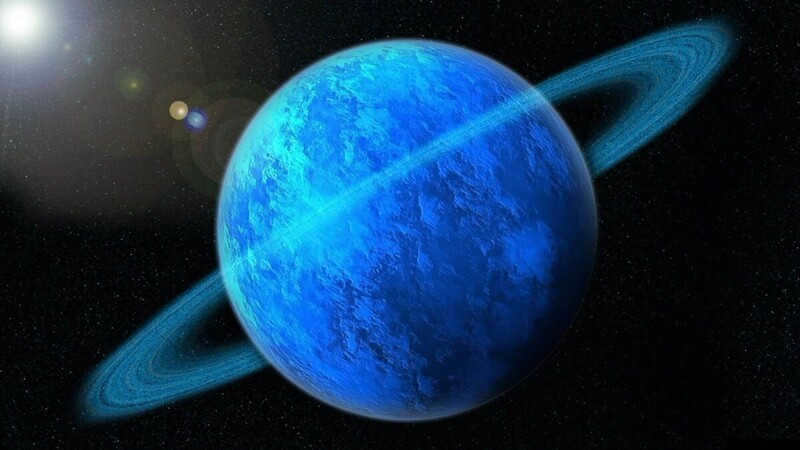
Scientists are not completely sure as to why Uranus experiences such frigid temperatures, even though it is closer to the Sun compared to Neptune. Some propose that this may be due to the planet’s peculiar orientation.
Arriving at a definitive conclusion is challenging, as attributing the low temperatures solely to distance is disproven by the disparity between Neptune and Uranus. It is believed that Uranus follows an orbit with a unique inclination unmatched by any other planet. This tilt causes the planet to radiate a significant amount of heat into space while retaining very little. As a result, Uranus becomes colder than its planetary counterparts.
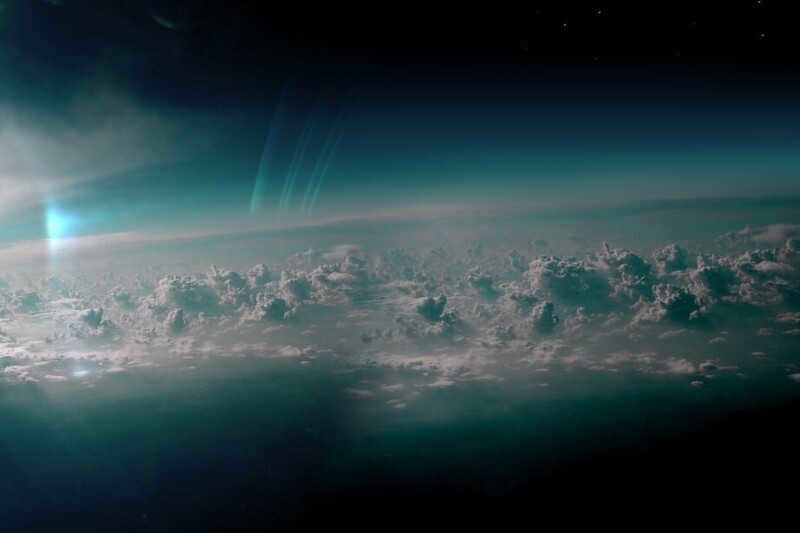
The predominant gases in the atmosphere of Uranus are molecular hydrogen and helium. The third most prevalent gas, following hydrogen and helium, is methane (CH 4 ). It is the methane in Uranus’ atmosphere that absorbs the red portion of visible light, resulting in its distinctive blue-green color.
Astronomers have identified three distinct layers within Uranus’ atmosphere: the troposphere (-500 km to 50 km), the stratosphere (50 km to 4,000 km), and the thermosphere/corona, which spans from 4,000 km to 50,000 km above the surface.
Titania holds the record for being the largest satellite in the solar system
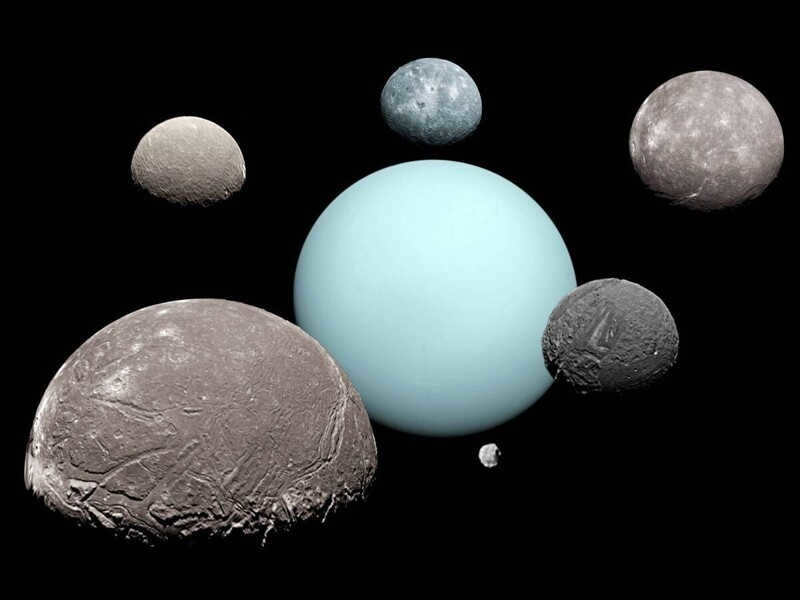

Thanks to the Voyager missions that explored the outer parts of our solar system during the late 1970s and early 1980s, scientists got their initial glimpse of Uranus and its group of moons.
Out of all these moons, none surpasses Titania in terms of size, mass, or surface area. Appropriately named, this moon with numerous craters and potholes was given the name Titania after the fictional Fairy Queen in William Shakespeare’s play A Midsummer Night’s Dream.
The recognition of Uranus as a planet was officially established in 1783
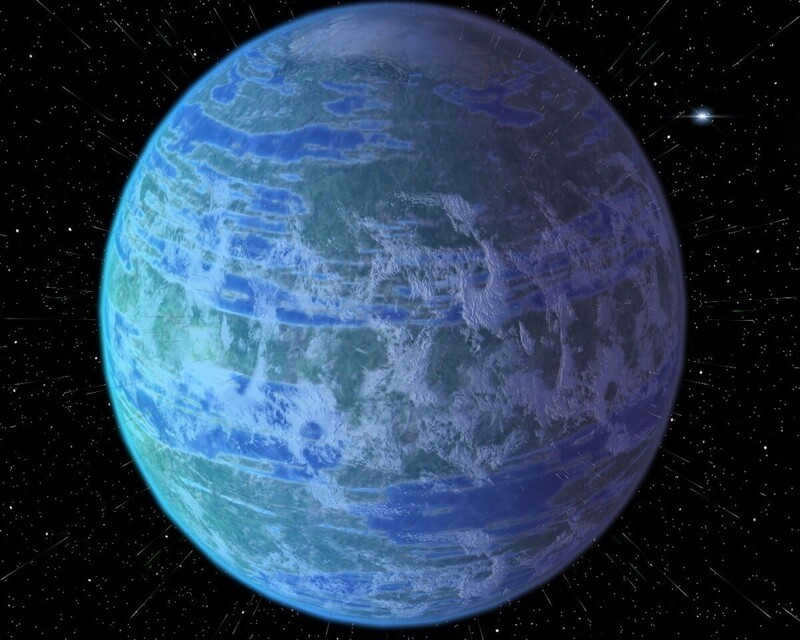
On April 26, 1781, William Herschel gazed at the heavens through his telescope in search of binary stars. His first recorded observation of the object occurred on March 13, 1781. Initially, he described it as a “hazy star or possibly a comet,” but later settled on it being a comet due to its apparent change in position.
While Herschel maintained that what he saw was a comet, his “discovery” sparked a lively debate within the astronomical community regarding the true nature of Uranus.
Over time, astronomers like Johann Ehlert Bode would ultimately determine that it was a planet based on its nearly circular orbit. By 1783, even Herschel himself acknowledged that it was indeed a planet.
Practically turning revolutions on its side
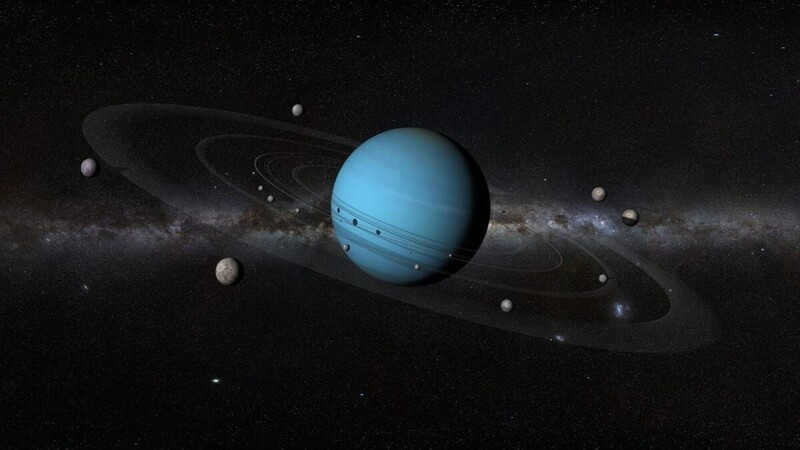
Uranus stands out among the planets with its unique characteristic of having its equator almost perpendicular to its orbit, tilted at an angle of 97.77 degrees. This peculiar tilt is believed to be the result of a past collision with an object similar in size to Earth. As a consequence of this distinctive tilt, Uranus experiences some of the most extreme seasons in the entire solar system.
During a significant portion of Uranus’ orbital period, each pole is directly exposed to the Sun, causing the other half of the planet to endure a prolonged winter lasting for 21 years. This phenomenon is highly unusual and adds to the planet’s enigmatic nature.
Furthermore, Uranus shares the distinction of being one of the two planets that orbit in the opposite direction than the majority of planets (the other being Venus), moving from east to west.
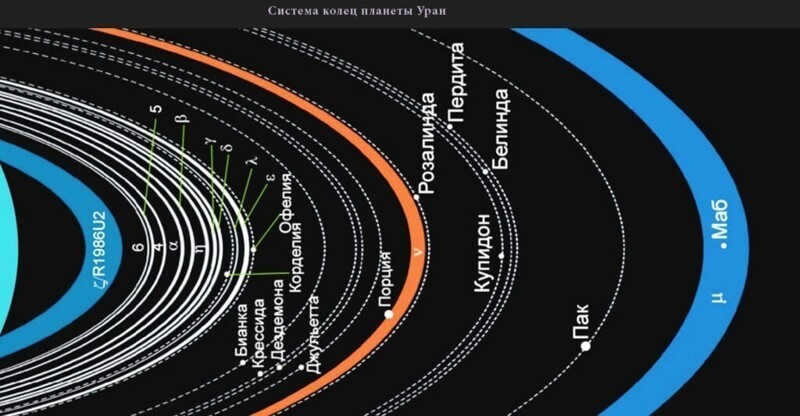
Uranus boasts a remarkable feature – it possesses not one, but two distinct sets of rings. The first set is composed of a total of nine rings, characterized by their narrow, dark gray appearance. Surrounding these inner rings are two outer rings. The innermost of these outer rings takes on a reddish hue, resembling the dusty rings found in other regions of our solar system. As for the outermost ring, it exhibits a stunning blue color, reminiscent of Saturn’s famous E ring.
When it comes to the arrangement of these rings in relation to the planet, they are named Zeta, 6, 5, 4, Alpha, Beta, Eta, Gamma, Delta, Lambda, Epsilon, Nu, and Mu in ascending order of distance. It is worth noting that certain larger rings are enveloped by belts of fine dust, adding an extra layer of intrigue to Uranus’ ring system.
Unusual atmospheric conditions observed on Uranus
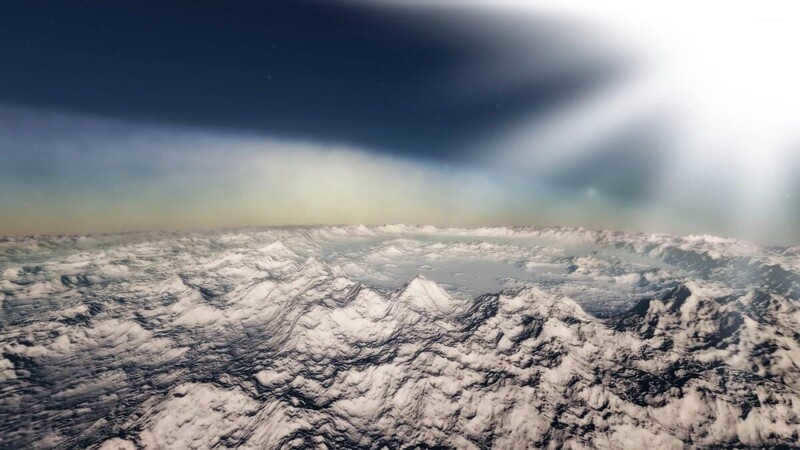
Throughout its 84-year revolution, Uranus experiences a unique phenomenon where the Sun illuminates its northern pole while the southern pole remains engulfed in darkness. As the planet continues its journey around the Sun, this scenario undergoes a complete transformation. Rather than evenly distributing heat across the equator, the Sun selectively warms one pole at a time, subsequently causing air currents to migrate towards the opposite pole.
However, there are some unique variations. The atmospheric conditions on Uranus resemble those found on Jupiter and Saturn, with organized bands of weather that encircle the planet. Despite its distinct tilt compared to Jupiter and Saturn, Uranus experiences internal heat that contributes significantly to its weather patterns. Surprisingly, this internal heat appears to have a greater influence on the planet’s weather system than the heat received from the Sun.
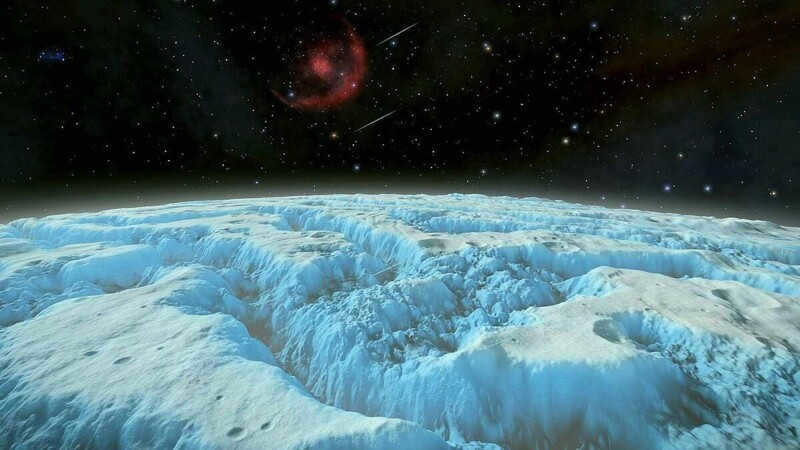
Similar to other gas giants, Uranus lacks a solid, well-defined surface. Instead, its atmosphere is comprised of gas, liquid, and ice that extends into the planet’s interior.
Uranus is the second least dense planet in our solar system, suggesting that it is primarily composed of ice. Unlike Jupiter and Saturn, which consist mainly of hydrogen and helium, Uranus contains only a small amount of these lighter elements. It also contains some rocky materials, equivalent to somewhere between 0.5 and 1.5 times the mass of Earth. However, the majority of the planet is composed of ice, predominantly water, methane, and ammonia.
Uranus is one of the planets in our solar system. It occupies the seventh position from the Sun and is the third largest in terms of radius. In terms of mass, it ranks fourth.
In 1781, the English astronomer William Herschel made the initial observation of the planet, which was subsequently named after Uranus, the ancient Greek god of the sky and the son of Cronus and grandson of Zeus.
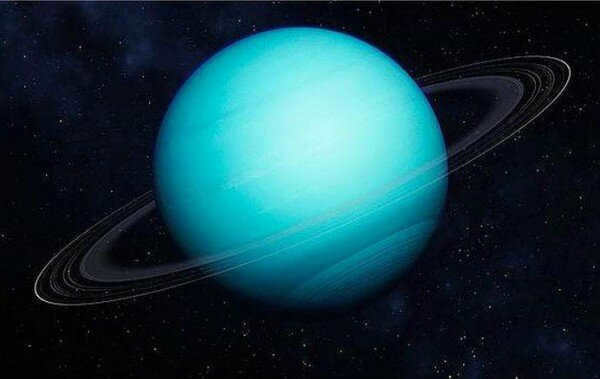
It is worth mentioning that Uranus is the inaugural planet to be identified during modern times with the aid of a telescope. This finding represented the first planet discovery since ancient times, thereby expanding the previously known limits of the solar system. Despite its considerable size, the planet had been observed from Earth before but had been mistaken for a dimly glowing star.
When comparing Uranus to gas giants like Jupiter and Saturn, which consist mainly of helium and hydrogen, it is notable that Uranus lacks hydrogen in its metallic form. Instead, the planet’s composition is rich in various forms of ice. In this aspect, Uranus bears a striking resemblance to Neptune, and these two planets are often categorized as “ice giants” by scientists. However, it is worth noting that the atmosphere of Uranus primarily comprises helium and hydrogen. More recently, traces of methane and hydrocarbon additives have been discovered in the planet’s atmosphere. Additionally, the atmosphere features ice clouds composed of solid hydrogen and ammonia.
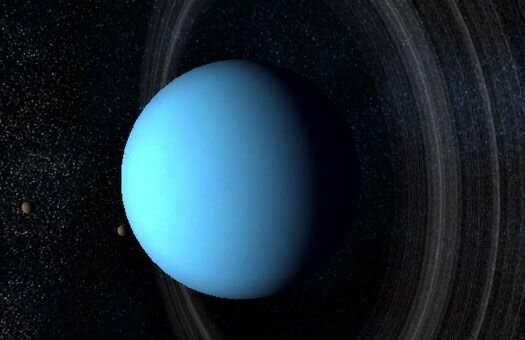
It should be noted that Uranus has the coldest atmosphere in the entire solar system. The lowest recorded temperature is -224 °C. Scientists believe that the planet’s atmosphere is composed of multiple cloud layers, with water occupying the lower layers and methane making up the upper layer. The planet’s interior is composed of rocks and ice.
Similar to other gas giants in the solar system, Uranus has a magnetosphere and a system of rings. It also has 27 permanent satellites, each with its own diameter and orbit. One unique feature of Uranus is its horizontal axis of rotation, which causes the planet to be tilted on its side in relation to the Sun.
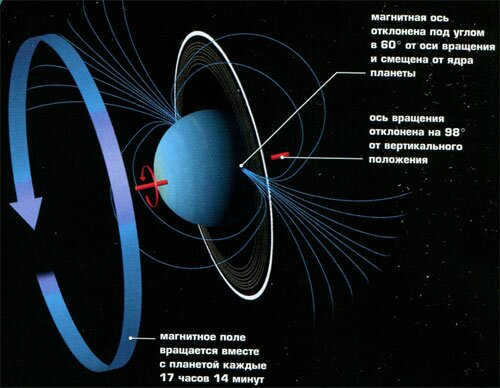
In 1986, the Voyager-2 spacecraft provided humanity with its initial set of high-resolution images of Uranus. Captured at a relatively short distance, these images revealed a seemingly unremarkable planet lacking distinct cloud bands or storms. However, recent studies have indicated that Uranus experiences seasonal variations in its atmosphere and is prone to frequent storms with wind speeds reaching up to 900 km/h.
Planet’s Discovery
The planet Uranus was mistakenly identified as a star before it was officially discovered by W. Herschel. Its first recorded observations can be traced back to 1660 when John Flemsteed, a renowned astronomer, documented his observations of the object. However, it wasn’t until 1781 that Pierre Monnier extensively studied the planet, observing it on more than 12 occasions.
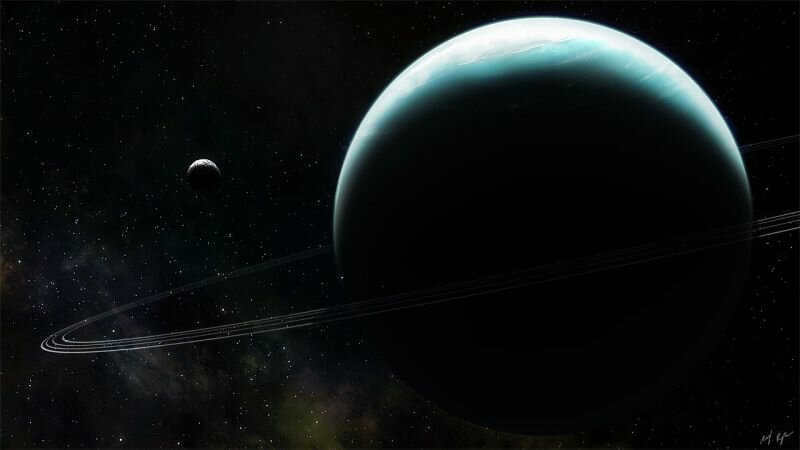
Herschel, a renowned scientist, was the first to deduce that Uranus is a planet and not a star. He initiated his research by analyzing the parallax of stars, utilizing a telescope that he constructed himself. On March 13, 1781, Herschel made his initial observation of Uranus in the garden adjacent to his residence in the city of Bath, located in Great Britain. In his journal, he documented the following entry: “In close proximity to the star ζ in the constellation Taurus, there exists a nebulous star or comet.” Four days later, Herschel made another entry: “Upon further investigation, it was discovered that the observed object had shifted positions, indicating that it is indeed a comet.”
Additional examinations of the celestial body through a powerful telescope revealed the comet as a hazy patch that was barely visible, while the nearby stars appeared clear and luminous. Multiple investigations confirmed it to be a comet. In April of that same year, the scientist received a report from fellow astronomer N. Maskelyne of the Royal Society, stating that no nucleus or tail was observed in this comet. As a result, it can be inferred that this could either be a comet with an extremely elongated orbit or a different celestial object altogether.
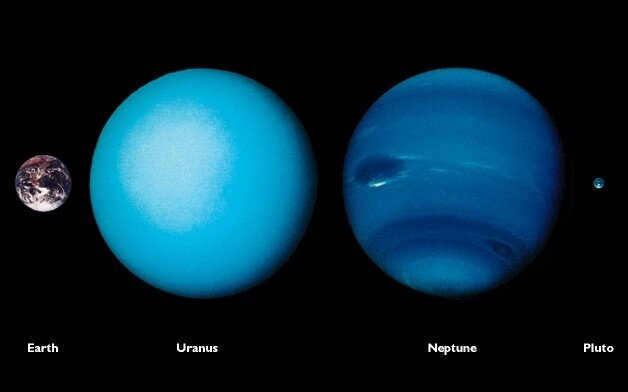
Herschel received a lifelong scholarship of 200 pounds from King George III for his discovery, with the condition that he and his family move closer to the king in order to observe celestial objects through the scientist’s telescope.
What the planet is called
Herschel, as the discoverer of a planet, received the esteemed privilege from the royal fellowship of astronomers to bestow a name upon the celestial body. Initially, the esteemed scientist had the intention of christening the planet “Star of George” in homage to King George III, known as “Georgium Sidus” in Latin. This appellation was chosen due to the contemporaneous belief that it was inappropriate to name a planet after an ancient deity. Furthermore, it would serve to pinpoint the moment of the planet’s discovery, as it could be inferred that it occurred during the reign of King George III.
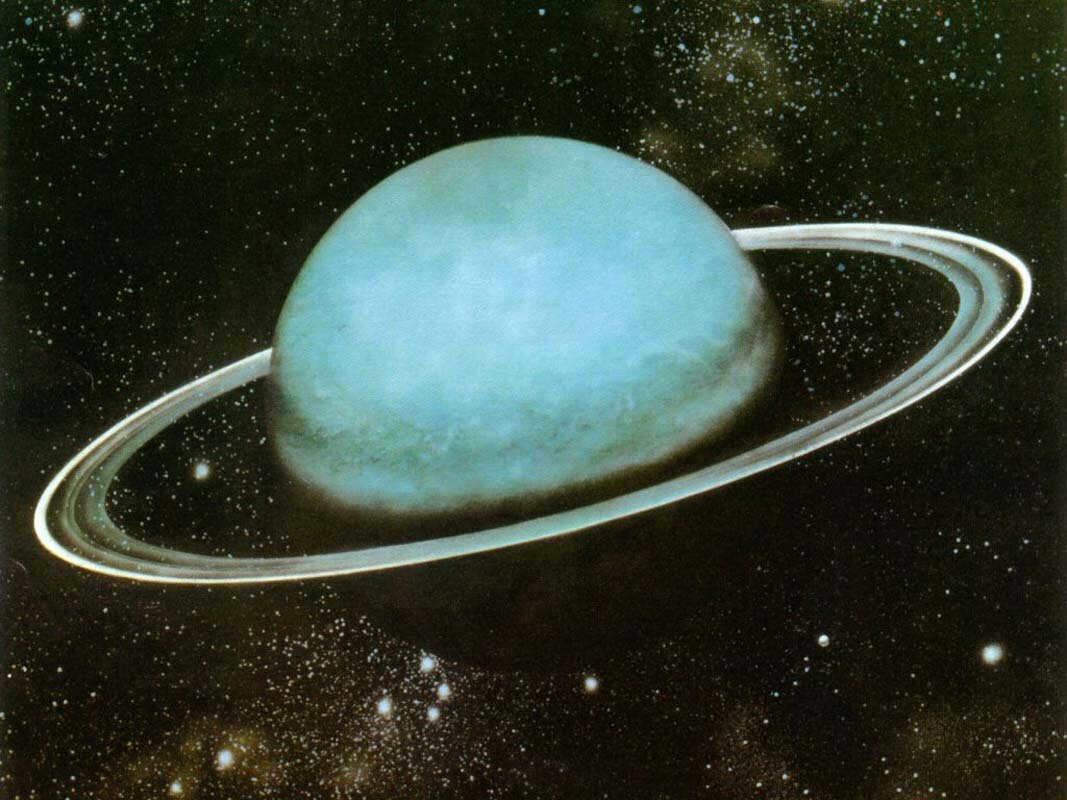
French scientist J. Landa also proposed naming the planet in honor of its discoverer. Suggestions were made to name it after Saturn’s mythological wife, Cybele. The name Uranus was put forward by German astronomer Bode, who chose it because this god was the father of Saturn. Within a year of Herschel’s death, the original name “George” was almost completely abandoned, although in Great Britain the planet was referred to as such for about 70 years.
The name Uranus has been officially assigned to the planet since 1850, when it was included in His Majesty’s Almanac. It is worth noting that Uranus is the only planet whose name comes from Roman mythology rather than Greek.
Uranus, the seventh planet from the Sun in our solar system, is located at a staggering distance of approximately 2.8 billion kilometers. This gas giant takes an astounding 84 Earth years to complete a full revolution around the Sun. The disparity between Uranus and Earth is immense, with a separation of 2.7 to 2.85 billion kilometers. The semi-major axis of Uranus’ orbit measures 19.2 astronomical units (a.u.), which is equivalent to nearly 3 billion kilometers. Within this vast expanse, the intensity of solar radiation is a mere fraction, approximately 1/400, of what it is within Earth’s orbit. The initial examination of Uranus’ orbit was conducted by Pierre Laplace, while subsequent improvements were made by John Adams in 1841, who also honed in on the gravitational forces at play.
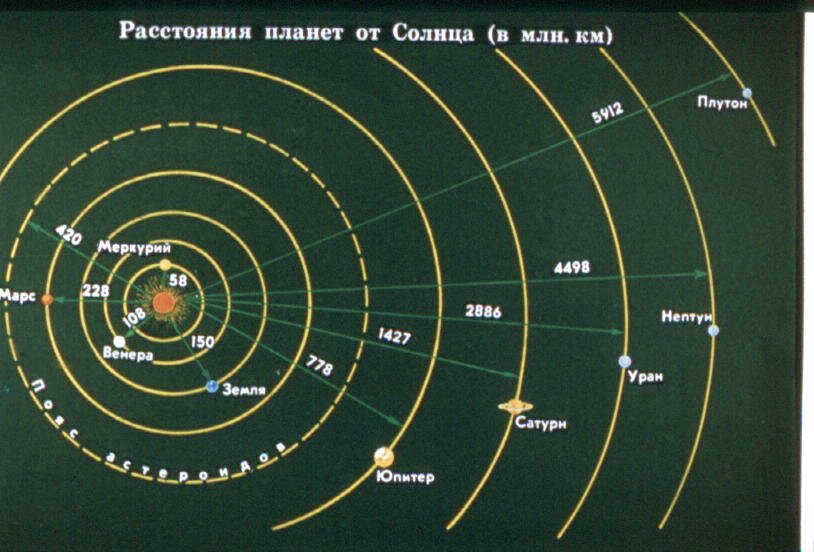
Uranus takes approximately 17 hours and 14 minutes to complete one revolution around its own axis. Similar to other gas giants, Uranus experiences strong winds that flow in the same direction as the planet’s rotation. These winds can reach speeds of up to 240 m/s. As a result, certain areas of the atmosphere, specifically those located in the southern latitudes, complete a full revolution around the planet in just 14 hours.
Tilt of Uranus’ Axis
One unique characteristic of Uranus is the inclination of its axis of rotation to the plane of its orbit, which is at an angle of 97.86 degrees. As a result, the planet is tilted on its side and rotates in a retrograde manner. This distinctive orientation sets Uranus apart from other planets and leads to a completely different pattern of seasons. While the rotation of all planets in the solar system can be likened to the motion of a wolf, Uranus’ rotation is more akin to that of a rolling ball. Scientists hypothesize that this unusual tilt may have been caused by a collision with planetesimals during Uranus’ formation.
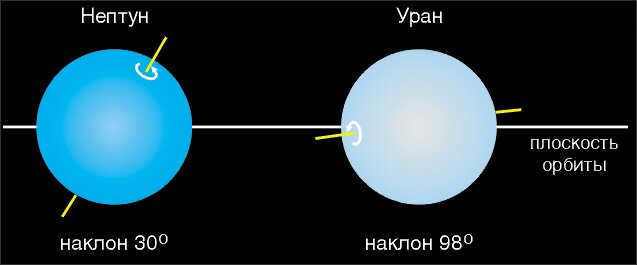
During the solstice on Uranus, one of the poles is directly facing the Sun, resulting in a dramatic shift between day and night at the equator and no sunlight reaching the opposite pole. This situation reverses after half a Uranian year, when the planet turns towards the Sun with its other pole. It is fascinating to note that each of Uranus’ poles remains in complete darkness for a duration of 42 Earth years, followed by 42 years of being illuminated by the Sun.
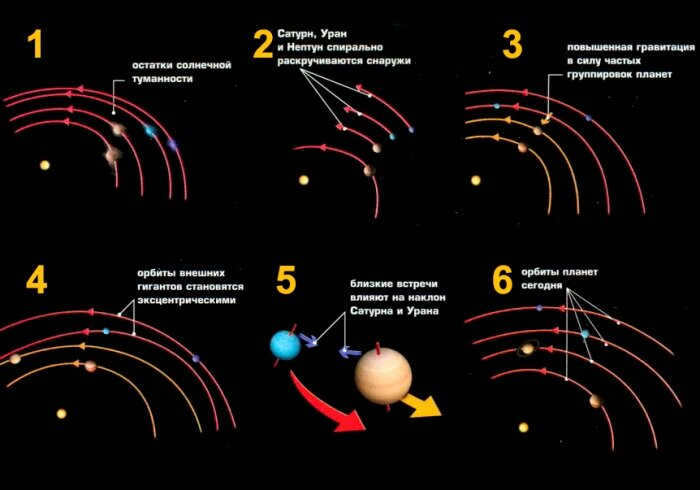
Despite the fact that the poles of the planet receive a significant amount of heat, the temperature at the equator remains consistently higher. The reason behind this phenomenon remains unknown to scientists. Furthermore, the exact positioning of the planet’s axis continues to be a mystery, as scientists have proposed several hypotheses that have yet to be substantiated by empirical evidence. The leading hypothesis regarding the tilt of Uranus’ axis suggests that during the formation of the solar system, a protoplanet of similar size to Earth collided with Uranus. However, this explanation fails to account for the absence of a similar axis tilt among the planet’s satellites. Another theory posits that Uranus once had a large satellite that perturbed its axis, only to be lost at a later time.
Observability of Uranus
From 1995 to 2006, the apparent magnitude of Uranus ranged from +5.6m to +5.9m, making it visible to the naked eye without the need for optical instruments. During this period, the angular radius of the planet varied from 8 to 10 angular seconds. In clear night skies, Uranus can be spotted without any aids, and even in urban areas, it can be observed with binoculars. When viewed through a small telescope, Uranus appears as a pale blue disk with some darkening around the edges. With more powerful telescopes equipped with a 25-centimeter lens, it is even possible to see Uranus’s largest moon, Titan.
Physical attributes of Uranus
Uranus, one of the giant planets in the solar system, has distinct physical characteristics. It is approximately 14.5 times more massive than Earth, making it the least massive among the giant planets. However, its density is relatively low at 1.270 g/cm³, which is the second lowest after Saturn. Despite having a larger diameter than Neptune, Uranus still has a lower mass. Scientists believe that this indicates the presence of ice made of methane, ammonia, and water in Uranus. Helium and hydrogen, while present, make up only a small portion of the planet’s overall mass. The core of Uranus is hypothesized to be composed of rocks.
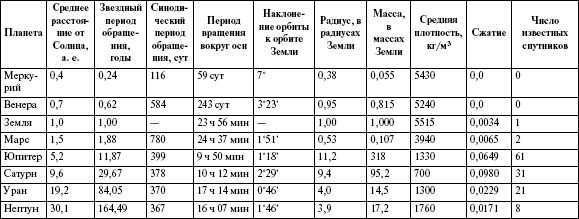
When discussing the composition of Uranus, it is commonly divided into three main components: the inner region (core) is made up of solid rocks, the middle region consists of multiple layers of ice, and the outer region is composed of a helium-hydrogen atmosphere. The core of the planet accounts for approximately 20% of its radius, while the icy mantle makes up 60%, and the atmosphere occupies the remaining 20%. The highest density is found in the core, where it reaches 9 g/cm³, and this area also experiences high pressures, reaching up to 800 Gpa.

It is important to note that ice shells on Uranus are not composed of traditional ice, but rather a dense liquid with a high temperature. This liquid is a combination of methane, water, and ammonia, and it exhibits exceptional electrical conductivity. While the proposed structural model is not universally accepted or proven, alternative theories about the composition of Uranus are being considered. It is worth mentioning that current technology and research methods are unable to definitively answer all of humanity’s questions.
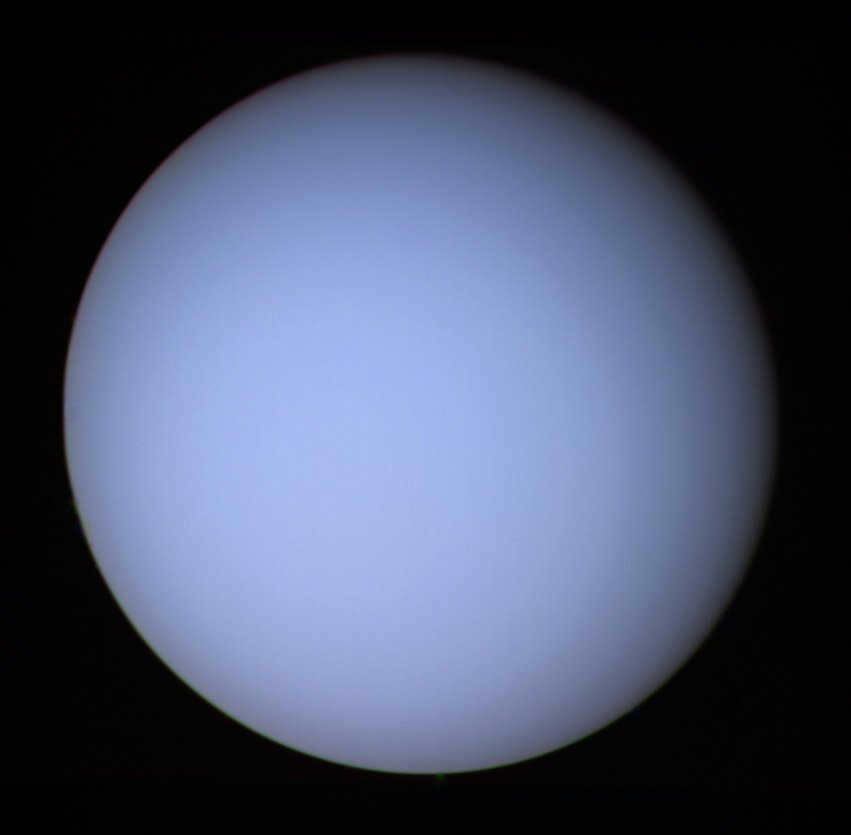
However, Uranus is commonly recognized as an oblate spheroid, with a polar radius of approximately 24.55 and 24.97 thousand kilometers.
Another distinctive feature of Uranus is its significantly lower internal heat compared to other gas giant planets. The reason for this planet’s low heat flux remains unknown to scientists. Even Neptune, which is similar in many ways but smaller, emits 2.6 times more heat into space than it receives from the Sun. Uranus, on the other hand, has very weak thermal radiation, measuring at approximately 0.047 W/m², which is 0.075 W/m² less than the Earth’s radiation. Further investigations have revealed that Uranus emits only about 1% of the heat it receives from the Sun. The coldest temperatures on Uranus have been recorded in the tropopause, reaching as low as 49 K, making it the chilliest planet in our solar system.
Scientists face significant challenges in determining the temperature of the interior of Uranus due to the limited availability of thermal radiation data. Nevertheless, there are theories suggesting that Uranus shares similarities with other giant planets in our solar system, raising the possibility of liquid water existing within its depths. These hypotheses open up the exciting prospect of potential life forms existing on Uranus.
The composition of Uranus’ atmosphere
Although Uranus does not possess a conventional solid surface, discussing its distribution and atmosphere can be quite complex. However, the outermost region of the planet is generally regarded as its atmosphere. Based on initial calculations, scientists estimate that the atmosphere extends approximately 300 kilometers away from the main body of Uranus. At this distance, the temperature is around 320 K with a pressure of 100 bar.
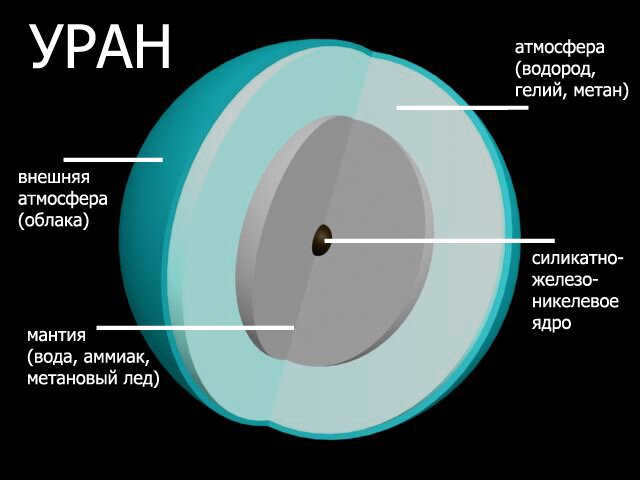
The diameter of Uranus’ atmosphere corona is twice that of the planet’s surface. Uranus’ atmosphere can be divided into three layers:
- The troposphere, which stretches from -300 to 50 kilometers with a pressure of about 100 bar.
- The stratosphere, with a pressure ranging from 0.1 to 10-10 bar.
- The thermosphere, also known as the corona, is located 4-50 thousand kilometers above the planet’s surface.
The atmosphere of Uranus is composed of various substances, including hydrogen and helium. Unlike other gas giants, helium is not located in the planet’s core but is found in its atmosphere. Another important component of Uranus’ atmosphere is methane, which is visible in the infrared spectrum but becomes less abundant at higher altitudes. Additionally, the upper layers of the atmosphere contain ethane, diacetylene, carbon dioxide, carbon monoxide, and water vapor particles.
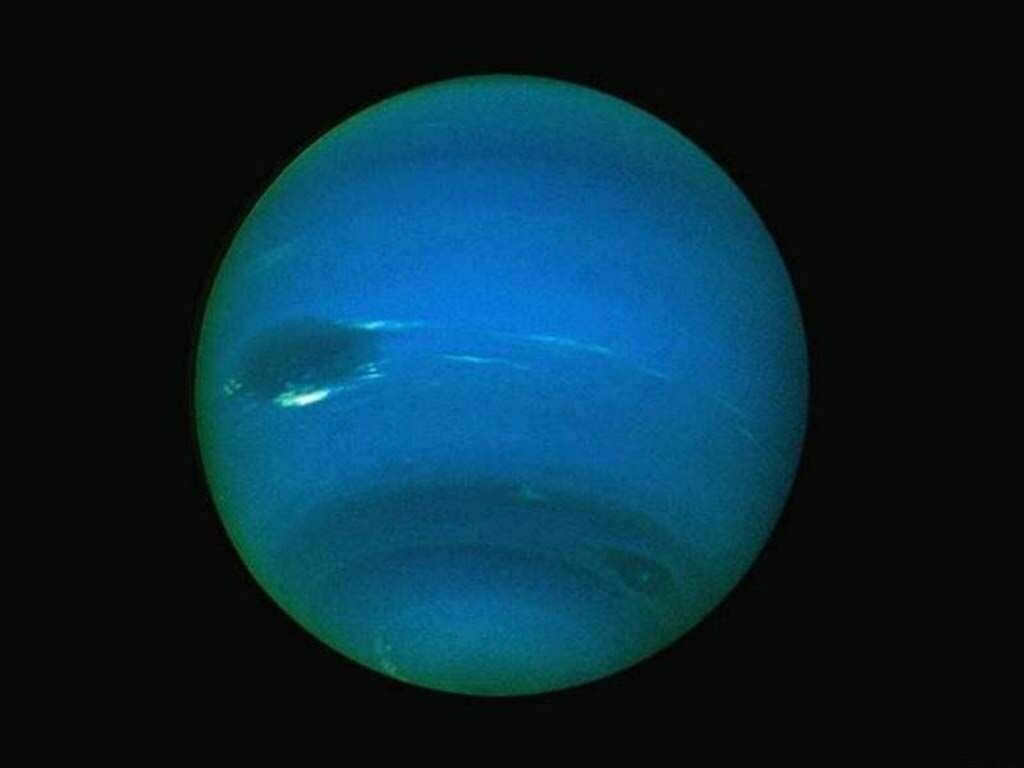
Discovering the Rings of Uranus
Uranus, an enigmatic planet in our solar system, boasts a remarkable feature – a complex system of rings. These rings, although faintly visible, are composed of small dark particles. Technological advancements have allowed scientists to delve deeper into the planet’s structure, leading to the discovery of 13 distinct rings. Among them, the ε ring shines the brightest. Interestingly, these rings are relatively young, as evidenced by their close proximity to each other. It is believed that their formation occurred simultaneously with the planet’s own creation. There is speculation that the rings may have originated from the remnants of Uranus’ satellites, which collided and disintegrated over time.
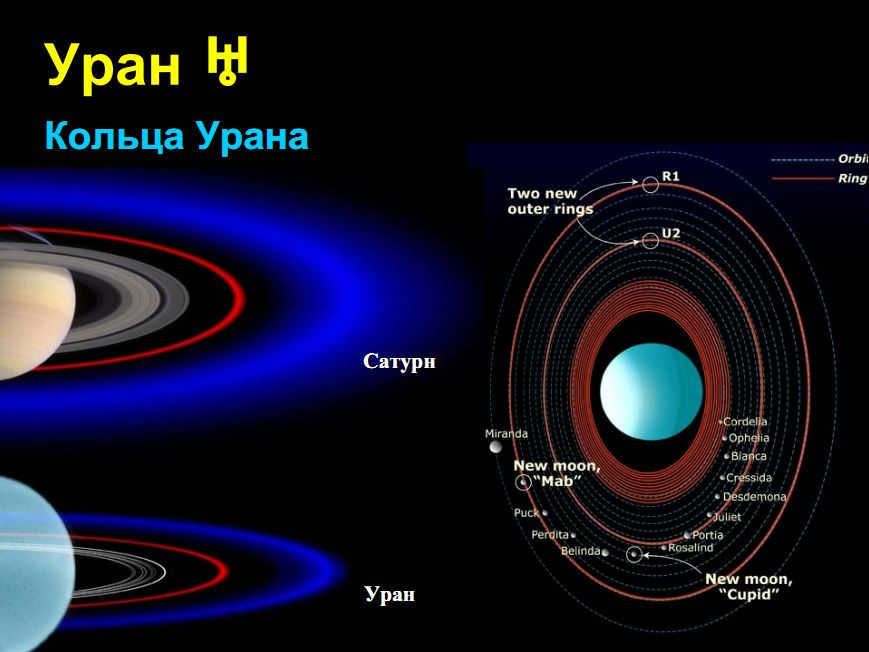
The rings around Uranus were first mentioned by Herschel, but their existence has been questioned since no one has observed them for the past two centuries. It was not until 10.03.1977 that the presence of rings in Uranus was officially confirmed.
Satellites of Uranus
Uranus is accompanied by 27 permanent natural satellites, each varying in diameter, composition, and orbit around the planet.
The largest natural satellites of Uranus are:





